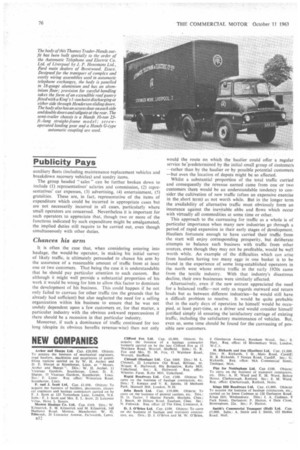Chances his arm
Page 78

If you've noticed an error in this article please click here to report it so we can fix it.
It is often the case that, when considering entering into haulage, the would-be operator, in making his initial survey of likely traffic, is ultimately persuaded to chance his arm by the assurance of a reasonable amount of traffic from at least one or two customers. That being the case it is understandable that he should pay particular attention to such custom. But although it might well provide a substantial proportion of his work it would be wrong for him to allow this factor to dominate the development of his business. This could happen if he not only failed to canvass for other traffic (on the grounds that he already had sufficient) but also neglected the need for a selling organization within his business to ensure that he was not unduly dependent upon a few customers or, for that matter, a particular industry with the obvious awkward repercussions if there should be a recession in that particular industry.
Moreover, if such a dominance of traffic continued for too long (despite its obvious benefits revenue-wise) then not only
would the route on which the haulier could offer a regular service be-predetermined by the initial small group of customers —rather than by the haulier or by possible potential customers —but even the location of depots might be so affected.
Whilst a substantial proportion of the total traffic carried and consequently the revenue earned came from one or two customers there would be an understandable tendency to consider the cultivation of new traffic (often an expensive exercise in the short term) as not worth while. But in the longer term the availability of alternative traffic must obviously form an insurance against the inevitable ebbs and flows which occur with virtually all commodities at some time or other.
This approach to the canvassing for traffic as a whole is of particular importance when many new industries go through a period, of rapid expansion in their early stages of development. Hauliers fortunate enough to have carried their traffic from the start will enjoy corresponding prosperity, but deliberate attempts to balance such business with traffic from other sources, even though they may not be profitable, would be wel worth while. An example of the difficulties which can arise from hauliers having too many eggs in one basket is to be found in the experience of some long-established operators in the north west whose entire traffic in the early 1920s came from the textile industry. With that industry's disastrous decline, their own businesses were similarly affected.
Alternatively, even if the new entrant appreciated the need for a balanced traffic—not only as regards outward and return loads but as between different industries—he would still have a difficult problem to resolve. It would be quite probable that in the early days of operation he himself would be occupied, at least part-time, as a driver and would consider himself justified simply it ensuring the 'satisfactory carriage of existing traffic, including the satisfactory maintenance of vehicles. But, even so, some time should be found for the canvassing of possible new customers.




















































































































